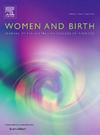Are the birth outcomes from a midwifery antenatal and postnatal service (MAPS) comparable to midwifery group caseload practice: A retrospective cohort study
IF 4.4
2区 医学
Q1 NURSING
引用次数: 0
Abstract
Midwifery continuity of care has demonstrated improved outcomes for mothers and babies including higher rates of spontaneous vaginal birth and more positive birth experiences, with health services cost savings, than non-continuity of care. However, midwives report challenges with continuity of care, such as on-call for labour/birth. Health services have responded with a new model, Midwifery Antenatal and Postnatal Service (MAPS), with care from a known midwife only during pregnancy and the early postnatal period. Women in the MAPS model have intrapartum care by rostered birth suite midwives (potentially unknown to the woman) whereas Midwifery Group Practice have a known midwife.
Aim
To determine if MAPS is associated with similar perinatal outcomes for women and babies as the Midwifery Group Practice (MGP) model.
Methods
A retrospective study was undertaken using de-identified routinely collected maternity data. All women who booked in and gave birth with MGP or MAPS at one hospital in New South Wales, Australia between April 2022 - April 2023. Descriptive and inferential statistics were used to describe the data.
Results
A total of 1303 births were analysed (MGP=349, MAPS =954). The MGP cohort were more likely to experience spontaneous labour (< 0.001) with local anaesthesia or no analgesia, vaginal births without instruments (<0.001), and exclusive breastfeeding at discharge (0.004) compared to MAPS births.
Conclusion
Continuity of care with a known midwife (antenatal, labour/birth, and postnatal) was associated with less intervention and improved breastfeeding rates as supported by international literature. Future research is needed comparing MAPS to standard fragmented midwifery care.
求助全文
约1分钟内获得全文
求助全文
来源期刊

Women and Birth
NURSING-OBSTETRICS & GYNECOLOGY
CiteScore
7.20
自引率
13.20%
发文量
371
审稿时长
27 days
期刊介绍:
Women and Birth is the official journal of the Australian College of Midwives (ACM). It is a midwifery journal that publishes on all matters that affect women and birth, from pre-conceptual counselling, through pregnancy, birth, and the first six weeks postnatal. All papers accepted will draw from and contribute to the relevant contemporary research, policy and/or theoretical literature. We seek research papers, quality assurances papers (with ethical approval) discussion papers, clinical practice papers, case studies and original literature reviews.
Our women-centred focus is inclusive of the family, fetus and newborn, both well and sick, and covers both healthy and complex pregnancies and births. The journal seeks papers that take a woman-centred focus on maternity services, epidemiology, primary health care, reproductive psycho/physiology, midwifery practice, theory, research, education, management and leadership. We also seek relevant papers on maternal mental health and neonatal well-being, natural and complementary therapies, local, national and international policy, management, politics, economics and societal and cultural issues as they affect childbearing women and their families. Topics may include, where appropriate, neonatal care, child and family health, women’s health, related to pregnancy, birth and the postpartum, including lactation. Interprofessional papers relevant to midwifery are welcome. Articles are double blind peer-reviewed, primarily by experts in the field of the submitted work.
 求助内容:
求助内容: 应助结果提醒方式:
应助结果提醒方式:


